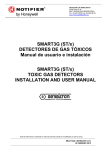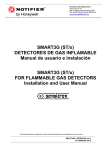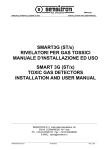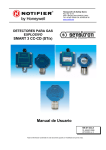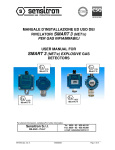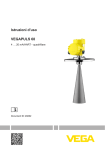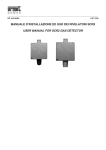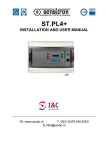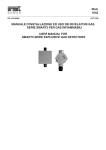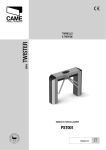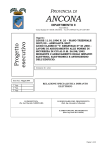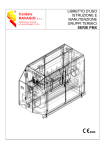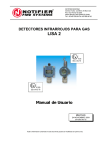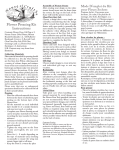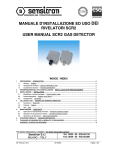Download MT1450 rev 1
Transcript
SMART3 NC MANUALE D’INSTALLAZIONE ED USO PER RIVELATORI DI GAS INFIAMMABILI E TOSSICI USER MANUAL FOR FLAMMABLE AND TOXIC GAS DETECTORS SENSITRON S.r.l. Viale della Repubblica, 48 20010 CORNAREDO MI - Italy Tel: + 39 02 93548155 Fax: + 39 02 93548089 e-mail: [email protected] MT1450 rev 1 20/04/2011 Page 1 of 14 Attenzione QUESTO MANUALE DEVE ESSERE LETTO ATTENTAMENTE DA TUTTI COLORO CHE HANNO O AVRANNO LA RESPONSABILITA' DI INSTALLARE, UTILIZZARE O DI PRESTARE UN SERVIZIO DI ASSISTENZA SU QUESTO PRODOTTO. Come ogni componente di un sistema, questo prodotto funzionerà correttamente solo se installato, utilizzato e controllato come prescritto dal fabbricante. IN CASO CONTRARIO, POTREBBE NON FUNZIONARE CORRETTAMENTE E LE PERSONE CHE AFFIDANO LA LORO SICUREZZA A QUESTO PRODOTTO POTREBBERO SUBIRE DANNI PERSONALI O LETALI. La garanzia riconosciuta da Sensitron s.r.l. su questo prodotto potrebbe essere nulla se il prodotto non venisse installato, utilizzato e controllato secondo le istruzioni fornite con il presente manuale. Per favore, proteggetevi seguendole attentamente. Invitiamo i nostri clienti a scriverci o a chiamarci per ogni informazione riguardo questo strumento, il suo uso o una sua eventuale riparazione. Warning THIS MANUAL MUST BE CAREFULLY READ BY ALL PERSONS WHO HAVE OR WILL HAVE THE RESPONSIBILITY FOR INSTALLING, USING OR SERVICING THIS PRODUCT. Like any equipment, this product will perform as designed only if installed, used and serviced in accordance with the manufacturer’s instructions. OTHERWISE, IT COULD FAIL TO PERFORM AS DESIGNED AND PERSONS WHO RELY ON THIS PRODUCT FOR THEIR SAFETY COULD SUFFER SEVERE PERSONAL INJURY OR DEATH. The warranties made by Sensitron s.r.l. with respect to this product are voided if the product is not installed, used and serviced in accordance with the instructions in this user guide. Please protect yourself and others by following them. We recommend our customers to write or call regarding this equipment prior to use or for any additional information relative to use or repair. MT1450 rev 1 20/04/2011 Page 2 of 14 INDICE / INDEX 1 1 2 2 3 3 INTRODUZIONE ...................................................................................................................................................... 4 INTRODUCTION...................................................................................................................................................... 4 1.1 Descrizione ....................................................................................................................................................................... 4 1.1 Description........................................................................................................................................................................ 4 1.2 Identificazione rivelatore .................................................................................................................................................. 4 1.2 Gas detectors identification ............................................................................................................................................. 4 1.3 Caratteristiche tecniche ................................................................................................................................................... 5 1.3 Technical specifications................................................................................................................................................... 5 PREDISPOSIZIONE DEL SITO D’INSTALLAZIONE.............................................................................................. 6 INSTALLATION SITE PREARRANGEMENT ......................................................................................................... 6 INSTALLAZIONE..................................................................................................................................................... 7 INSTALLATION ....................................................................................................................................................... 7 3.1 Modalità per il corretto montaggio .................................................................................................................................. 7 3.1 Correct positioning mode ................................................................................................................................................ 7 3.2 Schema topografico circuito............................................................................................................................................ 7 3.2 Detector circuit layout ...................................................................................................................................................... 7 3.2.1 Schema topografico scheda a 1 relè (opzionale)................................................................................................................. 7 3.2.1 1-relay card layout (optional)............................................................................................................................................... 7 3.2.2 Schema topografico scheda a 3 relè (opzionale)................................................................................................................. 7 3.2.2 3-relay card layout (optional)............................................................................................................................................... 7 3.3 Configurazione del rivelatore........................................................................................................................................... 8 3.3 Detector configuration...................................................................................................................................................... 8 3.4 Collegamento, modalità stand alone oppure uscita 4-20 mA......................................................................................... 9 3.4 Stand alone or 4-20 mA output connection..................................................................................................................... 9 3.5 Collegamento uscita seriale RS485 (opzionale)............................................................................................................ 10 3.5 RS485 serial output connection (optional).................................................................................................................... 10 3.5.1 Configurazione indirizzi..................................................................................................................................................... 10 3.5.1 Address configuration ....................................................................................................................................................... 10 4 4 5 5 6. 6. 7 7 8 8 9 9 COLLAUDO E USO............................................................................................................................................... 11 TESTING AND USE............................................................................................................................................... 11 4.1 Accensione ..................................................................................................................................................................... 11 4.1 Power ON ........................................................................................................................................................................ 11 4.2 Collaudo .......................................................................................................................................................................... 11 4.2 Testing............................................................................................................................................................................. 11 4.3 Uso................................................................................................................................................................................... 11 4.3 Use................................................................................................................................................................................... 11 MANUTENZIONE .................................................................................................................................................. 12 MAINTENANCE..................................................................................................................................................... 12 5.1 Manutenzione preventiva ............................................................................................................................................... 12 5.1 Preventive maintenance routines........................................................................................................................................ 12 5.2 Manutenzione correttiva................................................................................................................................................. 12 5.2 Corrective maintenance routines....................................................................................................................................... 12 5.3 Istruzioni per la dismissione .......................................................................................................................................... 12 5.3 Disassembly instructions............................................................................................................................................... 12 ISTRUZIONI PER L'IMBALLAGGIO ..................................................................................................................... 12 PACKING INSTRUCTIONS ................................................................................................................................... 12 SEGNALAZIONI DI ALLARME E DI GUASTO ..................................................................................................... 12 ALARM AND FAULT INDICATIONS..................................................................................................................... 12 ACCESSORI .......................................................................................................................................................... 13 ACCESSORIES ..................................................................................................................................................... 13 TAGLIANDO DI GARANZIA PER LA RIPARAZIONE.......................................................................................... 14 WARRANTY COUPON FOR REPAIRING ............................................................................................................ 14 MT1450 rev 1 20/04/2011 Page 3 of 14 1 INTRODUZIONE 1 INTRODUCTION 1.1 Descrizione 1.1 Description I Rilevatori di gas della serie SMART3 NC vengono impiegati per rilevare la presenza di sostanze combustibili (%LEL) e tossiche (ppm) in aree sicure. SMART3 NC gas detectors are used to detect the presence of combustible (%LEL) and toxic (ppm) gases in non classified areas. Il sensore catalitico utilizzato nelle versioni standard per miscele esplosive conferisce una precisione ed una selettività ottimale, evitando al massimo falsi allarmi. Le celle elettrochimiche utilizzate per i gas tossici consentono ai rilevatori di rilevare la presenza di sostanze tossiche anche a concentrazioni molto basse. The catalytic sensor employed for the detection of flammable compounds offers a great precision and selectivity, thus avoiding false alarms. The electrochemical cells employed for the detection of toxic gases allow the measurement of toxic compounds at very small contents. Il microprocessore presente sulla scheda elettronica del rivelatore è provvisto dei seguenti algoritmi software per correggere fenomeni transitori che potrebbero causare inprecisioni di lettura o falsi allarmi. Autodiagnosi del sistema, che verifica costantemente il corretto funzionamento dell’hardware, sensore compreso. Durante tale fase il LED rosso lampeggia molto lentamente Inseguitore di Zero per il mantenimento del parametro del sensore prescindendo da possibili derive dovute a variazioni termiche o fisiche del sensore stesso. Filtro digitale che consente di correggere fenomeni transitori che potrebbero causare una instabilità del sistema o errori di lettura con conseguenti falsi allarmi; Ciclo d’isteresi applicato alle uscite digitali associate alle soglie d’allarme per consentire l’eliminazione delle continue commutazioni in prossimità dei punti di soglia. Watch-dog per il controllo del microprocessore. In caso di intervento la corrente di uscita viene forzata a 0 mA. Il LED rosso di segnalazione resta acceso. Se sul rilevatore è presente la scheda seriale RS485, la trasmissione viene interrotta; se sul rilevatore è installata la scheda 3 relè, il relè di Fault si attiva. Il Rivelatore fornisce una uscita proporzionale in corrente (4-20 mA) corrispondente allo 0-100% del fondo scala. The management software incorporates algorithms designed to correct the effects of transients, which may cause unstable operation or incorrect readings with associated false alarms. Software algorithms are: Self diagnostic procedure to control the detector main operational parts, both hardware and sensing element. During this phase the red LED blinks very slowly Zero point tracking to maintain the zero parameter of the sensor apart from possible drifts due to thermal or physical variations of the sensor. Digital filter employed in the digital analysis of the analogue values sampled, it allows correcting phenomena that might cause system's instability or wrong readouts thus provoking false alarms. Hysteresis cycle applied to the digital outputs to eliminate continuous switching close to the preset alarm thresholds. Watch-dog for the microprocessor control. In case of intervention the output current drops down to 0mA. The red LED stops blinking and remains on. If the serial board RS485 has been connected, the communication will be interrupted; if the 3-relay card is plugged in, the Fault relay will activate. The detector offers a proportional output current (4-20mA) corresponding to 0-100% Full scale range. Tre schede opzionali sono disponibili per offrire le seguenti prestazioni: -Scheda 3 relè (STS3REL) con contatti puliti liberi da tensione. Un relè è associato all'uscita di Fault e watchdog mentre gli altri due possono essere associati a due delle tre soglie di allarme presenti. -Una scheda a 1 relè (STS1REL) che permette di ottenere un’ uscita con contatto pulito libero da tensione degli stati di Allarme e/o Guasto del rivelatore. -una scheda interfaccia seriale (STS/IDI) tramite la quale il rivelatore è in grado di dialogare in seriale RS485 con le centrali Sensitron indirizzate. Three optional cards are available to offer the following facilities: -A three-relay card (ST.S3REL) with tension free changeover contacts. One relay is associated to Fault and Watch-dog. The remaining two are to be associated to two out of the three preset thresholds. -A one-relay card (STS1REL) to offer one tension free changeover contact, to be either associated to Fault or to Alarm status. -A RS485 interface to make the detectors communicate on RS485 bus with Sensitron's control panels 1.2 1.2 Identificazione rivelatore Gas da rilevare Gas to detect Gas detectors identification CH4 GPL LPG Vap. benzina Petrol vapors CO NO2 CO2 Modello P/N S1455ME S2396ME S1455GP S2396GP S1455VB S2396VB S1450CO S1451ND S2401CO2 Sensore Campo misura Sensor type Catalytic Catalytic Catalytic Electrochem. Electrochem. IR 0-100% LEL 0-100% LEL 0-100% LEL 0-300 ppm 0-20 ppm 0-5000 ppm MT1450 rev 1 Range 20/04/2011 Page 4 of 14 1.3 Caratteristiche tecniche Elemento sensibile Campo di misura Risoluzione Alimentazione Assorbimento a 12Vcc Unità di controllo Segnalazioni luminose Uscita proporzionale Resistenza max. di carico Uscita seriale (opzionale) Uscite a relè (opzionale) Procedura di autozero Filtro digitale Risoluzione µP Watch-dog Precisione Ripetibilità Tempo preriscaldamento Tempo stabilizzazione Tempo di risposta Temp. di stoccaggio Temperatura operativa Umidità relativa Pressione di esercizio Velocità dell’aria Peso Dimensioni: Orientamento MT1450 rev 1 1.3 %LEL: Catalitico CO e NO2: cella elettroch. CO2: Infrarosso %LEL: 0-100% LEL CO: 0-300 ppm NO2: 0-20 ppm CO2: 0-5000 ppm Out analog 0,025 mA 12-24 Vcc -20% + 15% 90mA medio; 130 mA max Microprocessore 10 bit LED ad intermittenza 4-20 mA (default) 200Ω RS-485 Modbus RTU N° 3 relè contatti in scambio liberi da tensione 24V-1A Compensazione derive di zero medie mobili sui valori acquisiti 1024 punti Per controllo microprocess. ±5% F.S. o 10% lettura ±5% F.S. o 10% lettura 5 minuti < 2 minuti < 20 sec. T50; < 60 sec. T90 -25 / + 60 °C -10 / + 60 °C 20-90 % Rh / 40° C 80-110 KPa < 6 mS Kg 0.500 mm 106x65 h 180 Installazione verticale con sensore rivolto verso il basso Technical specifications Sensing element Measurement range Resolution Power supply Consumption at 12Vdc Control unit Visual indications Proportional output Max.load resistance Serial Output (optional) Relay outputs (optional) Auto zero routine Digital filter Resolution µP Watch-dog Accuracy Repeatability Warm-up time Stabilization time Response time Storage temperature Operating temperature Relative humidity Operative pressure Air velocity Weight Dimensions Positioning 20/04/2011 %LEL: catalytic sensor CO and NO2: electroch. Cell CO2: Infrared %LEL: 0-100% LEL CO: 0-300 ppm NO2: 0-20 ppm CO2: 0-5000 ppm Out analog 0,025 mA 12- 24 Vdc - 20% + 15% 90mA medium; 130mA max. Microprocessor 10 bit Flickering LED 4-20 mA (default) 200Ω RS 485 Modbus RTU 3 relays with tension free changeover contacts 24V-1A Zero drift compensation variable average on the values sampled 1024 dots For microprocessor control ±5% full scale or 10% reading ±5% full scale or 10% reading 5 minutes < 2 minutes < 20 sec. T50 < 60 sec. T90 -25 / + 60 °C -10 / + 60 °C 20-90 % Rh / 40° C 80-110 KPa < 6 mS Kg 0.500 mm 106x65 h 180 To be mounted sensor head downward Page 5 of 14 2 PREDISPOSIZIONE DEL SITO D’INSTALLAZIONE 2 INSTALLATION SITE PREARRANGEMENT Durante le operazioni di montaggio e installazione, gli impianti devono essere messi in sicurezza. Durante l'installazione è importante tenere in considerazione alcune norme generali in quanto un posizionamento non corretto può pregiudicare il funzionamento ottimale del rivelatore. Si raccomanda di non installare rivelatori gas nelle vicinanze di prese d’aria e/o ventilatori che provocano forti correnti d’aria. I rivelatori non devono essere altresì posti in zone nelle quali siano presenti vibrazioni e, sebbene immuni da disturbi a radiofrequenze è consigliabile non installarle in prossimità di emettitori radio (ponti radio o apparecchiature simili). Altra buona norma è quella di installare il rivelatore in zone facilmente accessibili per le operazioni di test e calibrazione e per l’inserimento dell’adattatore del kit di calibrazione. At the mounting/installation phase be sure all safety precautions have been considered. Always consider how important it is the correct positioning of gas detectors to get the optimum response. An incorrect positioning can jeopardise the detector functioning. We recommend never installing gas detectors close to air intakes or fans causing strong air currents. Be sure the detectors are attached to a firm base to prevent vibration that can damage them, producing unreliable results. Although the electronics comply with the electromagnetic compatibility rules, it is advised to keep the detectors at a distance from any radio frequency senders (such as radio links or similar). Please be also sure that detectors are placed in a convenient location for future maintenance and calibration requirements. Il METANO è un gas più leggero dell’aria e, disperdendosi nell’ambiente, tenderà a salire verso l'alto; il rivelatore deve quindi essere posizionato a 30 cm dal soffitto per ottenere un efficace intervento. METHANE is a gas lighter than air and it tends to spread upwards; the detector should be placed at 30 cm from the ceiling in order to maximise the effectiveness of the detection. GPL e VAPORI DI BENZINA sono gas più pesanti dell'aria. Disperdendosi stazioneranno nella parte bassa dell’ambiente ed il rivelatore deve quindi essere posizionato a 30 cm dal pavimento. LPG and PETROL VAPOURS are gases heavier than air and tend to spread downwards; the detector should be placed at 30 cm from the floor to maximise the effectiveness of the detection. Il MONOSSIDO DI CARBONIO (CO) ha un peso specifico simile a quello dell’aria; è un gas molto tossico e per una protezione ottimale il rivelatore deve essere installato alla altezza della respirazione, quindi a circa m 1.60 dal pavimento. CARBON MONOXIDE (CO) has a specific weight similar to air's; it is a very toxic gas and to get a reliable protection, the detector should be placed at the breathing level, approximately 1.60m above the floor. L'ANIDRIDE CARBONICA (CO2) è un gas più pesante dell'aria. Disperdendosi stazionerà nella parte bassa dell’ambiente ed il rivelatore deve quindi essere posizionato a 30 cm dal pavimento. CARBON DIOXIDE (CO2) is a gas heavier than air and tends to spread downwards; the detector should be placed at 30 cm from the floor to maximise the effectiveness of the detection. Il BIOSSIDO D'AZOTO (NO2) è un gas più pesante dell'aria. Disperdendosi stazionerà nella parte bassa dell’ambiente ed il rivelatore deve quindi essere posizionato a 30 cm dal pavimento. NITROGEN DIOXIDE (NO2) is a gas heavier than air and tends to spread downwards; the detector should be placed at 30 cm from the floor to maximise the effectiveness of the detection. Vi sono alcune sostanze che, se presenti nell'atmosfera da analizzare, possono alterare considerevolmente la risposta del sensore fino a danneggiarlo irrimediabilmente (es. siliconi, silicati alogeni, tetraetile di piombo, acido solfidrico, tetracloruro di carbonio tricloroetilene-trielina ). Allorché si presuma la presenza di queste sostanze, si consiglia di verificare frequentemente - e sempre dopo ogni intervento degli allarmi - la sensibilità del rilevatore con gas di taratura There are some substances that, when present in the atmosphere being analysed, can considerably change the response of the sensor and even damage it irremediably, in particular silicones, silicon halides, tetraethyl lead, hydrogen sulphide, carbon tetrachloride, trichloroethylene Whenever their presence is presumed, it is recommended to check the detector's sensitivity at short time intervals, and always after an alarm intervention, with sample gas bottles. Il rilevatore è già calibrato in fabbrica. E’ successivamente possibile eseguire delle regolazioni utilizzando la tastiera di calibrazione tipo ST.CKD. Detectors are factory calibrated. Future adjustments of the calibration parameters can be carried out via the ST.CKD calibration keypad. MT1450 rev 1 20/04/2011 Page 6 of 14 3 INSTALLAZIONE 3 INSTALLATION 3.1 Modalità per il corretto montaggio 3.1 Correct positioning mode Il rivelatore deve sempre essere installato con l’elemento sensibile (testa di rivelazione) rivolta verso il basso. Il contenitore del rivelatore, per nessuna ragione deve essere forato: per il fissaggio utilizzare i fori già esistenti. The detector is always to be mounted with the sensing element placed downward. For no reasons at all the enclosure can be drilled. To wall mount the detector, please use the existing holes. 3.2 3.2 Schema topografico circuito Circuito rivelatore SMART3 NC Detector circuit layout Morsettiera di collegamento estraibile (Main plugin terminal board for connections) Led di indicazione di stato (Status led indication) Connettore per (Plug in terminal for): - Scheda Rs485 o (RS485 board or) - Scheda a un rele o due open collector o (One relay or two open collector board) 1 2 3 DIP-SWITCH per selezionare le soglie (Thresholds setting point DIP-SWITCH) 1 2 3 4-20mA Uscita negativa “DEFAULT” (4-20 mA Negative output mode, default) 4-20mA Uscita positiva (4-20 mA Positive output mode) J11 Connettore per scheda display o relè (J11 Plug in connettor for display or relay board) Connessione elemento sensibile (Sensing element connection) Scheda amplificatore Amplifier Board 3.2.1 Schema topografico scheda a 1 relè (opzionale) 3.2.1 1-relay card layout (optional) Consultare il manuale fornito con la stessa Please refer to the technical instruction supplied along with the card. 3.2.2 Schema topografico scheda a 3 relè (opzionale) 3.2.2 3-relay card layout (optional) Consultare il manuale fornito con la stessa Please refer to the technical instruction supplied along with the card. MT1450 rev 1 20/04/2011 Page 7 of 14 3.3 Configurazione del rivelatore 3.3 Detector configuration Il rilevatore fornisce un'uscita proporzionale proporzionale 4-20mA. The detector always provides a 4-20mA proportional output. Il rilevatore viene calibrato per il gas specificato al momento dell'acquisto. Successivamente è possibile verificarne la taratura utilizzando la tastiera di taratura come specificato al paragrafo 8. Detectors are factory calibrated for the specific gas required by the customers. Future adjustments of the preset calibration can be carried out by using the calibration keypad as detailed at paragraph 8. E’ possibile ottenere uscite a 0-10-20mA corrispondenti a: -0mA: condizione di normale funzionamento o guasto -10mA: superamento prima soglia di allarme -20mA: superamento seconda soglia di allarme It is also possible to get outputs set at 0-10-20mA corresponding to: -0mA: correct working condition or Fault -10mA 1st alarm threshold attainment -20mA 2nd alarm threshold attainment. Configurando diversamente i dip-switch presenti sulla scheda base si possono modificare le soglie di allarme. Anche disponendo della scheda opzionale a 3 relè è possibile modificare le soglie di intervento dei relè come indicato nella tabella seguente: MT1450 rev 1 By modifying the dipswitches configuration on the PCB, different alarm thresholds might be obtained. It is also possible to modify the relay intervention when using the 3-relay card, as per the following table: 20/04/2011 Page 8 of 14 3.4 Collegamento, modalità stand alone oppure uscita 4-20 mA 3.4 Stand alone or 4-20 mA output connection Verificare che nella confezione ci siano tutte le parti componenti. Per il collegamento del sensore con la centrale e alimentazione si raccomanda l'uso di cavo schermato. La sezione del cavo da utilizzare dipende dalla distanza del rilevatore dalla centrale: -per distanze inferiori a m 100 si usino cavi con sezione di 2 0.75 mm ; -per distanze comprese fra m 100 e 200 si usino cavi con 2 sezione di 1.0 mm ; -per distanze comprese fra m 200 e 300 si usino cavi con 2 sezione di 1.5 mm . Nel caso vi siano giunzioni nel cavo di collegamento, assicurarsi che vi sia continuità anche sulla schermatura dei cavi. Ricordasi che la schermatura deve essere collegata a terra unicamente dal lato unità di controllo o gruppo di alimentazione, mentre non dovrà mai essere collegata sui rilevatori. Assicurarsi che la realizzazione di giunzioni sui cavi di alimentazione mediante dispositivi di serraggio o a crimpare, sia eseguito a regola d’arte con capicorda e/o morsetti che nel tempo non si ossidino o allentino. E’ sempre preferibile eseguire giunzioni saldate. Il rilevatore SMART3 NC può essere collegato a centrali di tipo analogico 4-20 mA con indicazione proporzionale della concentrazione di gas in ambiente. Please check the carton box comprises all of the components. Wiring between the detector and the control panel should be carried out with shielded cables. Wires' cross section depends on the distance between the control panel and the detector: -for a distance up to m 100 we advice a 3 core wire with 2 cross section area of 0.75 mm ; -for a distance between m 100 and 200 we recommend a 2 3 core wire with cross section of 1.0 mm ; -for a distance between m 200 and 300 we recommend a 2 3 core wire with cross section 1.5 mm . Should any junctions be necessary on the wires, please make sure there is no interruption on the shield. Please remember that the shield is to be ground connected from the control panel side only. Pay attention never to connect the shield to the connectors. Ensure the wire connections, either clutching or crimping type, are duly carried out with terminals that do not oxidise or loosen. Better of all would be to solder them. The SMART3 NC gas detectors are designed to be connected to any control unit accepting a 4-20 mA input signal, better when panels have an LC display for the proportional readout of the concentration. SCHEMA COLLEGAMENTO per 4-20 mA 4-20 mA CONNECTION DIAGRAM N.B. Nel caso di centrali con ingresso 4-20 mA è possibile collegare 1 solo rilevatore a ciascun ingresso. N.B.: Control panels accepting 4-20mA input signals allow the connection of only one detector per input. MT1450 rev 1 20/04/2011 Page 9 of 14 3.5 Collegamento uscita seriale RS485 (opzionale) 3.5 RS485 (optional) serial output connection In questo tipo di collegamento servono 4 conduttori: 2 per la seriale RS485 e 2 per l’alimentazione dei dispositivi. A questo scopo si suggerisce l’utilizzo di due diversi cavi oppure di un solo cavo che abbia le caratteristiche adatte, si seguito descritte. -) Il collegamento della seriale RS485 deve essere realizzato con cavo per connessioni EIA RS 485: n.2 conduttori con sezione 0,22 / 0,35 mmq + schermo (COPPIA TWISTATA). Capacità nominale tra i conduttori < 50 pF/m, impedenza nominale 120 ohm. Con questo tipo di collegamento la lunghezza totale della linea non deve superare i 1000 metri. Un esempio di cavo raccomandato è il BELDEN 9841 o similare (cavo per trasmissione dati in EIA RS485). Collegare i rilevatori (ed i moduli IN ed OUT) solo in modalità “cascata”. Si raccomanda di evitare collegamenti ad albero o a stella in quanto riducono l’immunità alle interferenze. -) L’alimentazione dei rilevatori deve essere realizzata con un cavo a due conduttori di sezione adeguata in base al numero di dispositivi collegati, alla distanza degli stessi dall’alimentatore ed alla corrente assorbita da ciascuno dei dispositivi. Ad installazione eseguita controllare che su tutti i rilevatori installati ci sia una tensione minima di 12 Vdc. In questa configurazione, i dip-switch presenti sulla scheda base dello SMART3 NC servono per stabilire l'indirizzo del rilevatore. Le soglie di allarme si imposteranno automaticamente alla configurazione di default. Per esigenze particolari contattare il fornitore. Utilizzando la RS485 l’uscita proporzionale 4-20mA rimane attiva. 4 wires are required in this type of connection: 2 for the RS485 serial bus and 2 for device power supply. For this reason we suggest you use two different wires or a single wire with suitable features as described below. -) The RS485 serial bus must be connected with an EIA 2 RS 485 connection cable: No. 2 wires with 0.22/0.35 mm section with shield (TWISTED PAIR). Nominal capacity between conductors < 50 pF/m, nominal impedance 120 ohm. Total line length with this type of connection must not exceed 1,000 metres. An example of a recommended cable is a BELDEN 9841 or similar wire (EIA RS485 data transmission wire). Only connect detectors in cascade. Avoid tree or star connections since they reduce interference immunity. -) The power supply to the detectors must be connected with a 2-core wire with adequate section based on the number of connected devices, their distance from the power supply and each device’s consumption. Once the installation has been completed and the system is powered-on, please make sure that each detector reaches at least 12 Vdc. When SMART3 NC detectors are connected the RS485 serial mode, the dip-switches on the PCB are to be used to set the detectors' address. Alarm thresholds will automatically set to the default configuration. For particular needs please contact the supplier. When detectors are RS485 connected, the proportional 420mA output remains active. Esempio di collegamento rivelatori SMART3 NC su bus RS485 Example of connection of SMART3 NC detectors to a RS485 bus line ALIMENTAZIONE POWER SUPPLY 12 / 24 Vdc Per il numero massimo di rivelatori collegabili alla linea RS485 e per l’indirizzamento dei rivelatori consultare il manuale tecnico fornito con la centrale For the maximum number of detectors connected to each RS485 line and for the address setting, please refert to the instruction manual supplied along with the control unit 3.5.1 Configurazione indirizzi 3.5.1 Address configuration Consultare il manuale fornito con la scheda seriale STS/IDI. Please refer to the technical instruction along with the serial interface STS/IDI. MT1450 rev 1 20/04/2011 Page 10 of 14 4 COLLAUDO E USO 4 TESTING AND USE 4.1 Accensione 4.1 Power ON Al momento in cui il circuito viene alimentato, il LED rosso sulla scheda base si accende ad intermittenza lenta. L’uscita in corrente è 1,5mA circa. Trascorsi 2 minuti circa, il LED rosso lampeggia con una frequenza pari allo stato in cui si trova il rilevatore (vedere tabella al punto 4.3) e l’uscita in corrente è a 4,0mA. Terminata la fase di preriscaldamento, il rilevatore è in grado di funzionare correttamente, sebbene siano necessarie 2 ore circa affinché il rilevatore raggiunga le prestazioni ottimali. When the detector is powered on, the red LED on the motherboard starts blinking at slow intermittence. Output current is nearly 1.5mA. After nearly two minutes, the red LED flash rate is equivalent to the detector working status (see table on paragraph 4.3) and the output current is 4.0mA. Once the warm-up is over the detector starts working correctly and does not need any further operation, although the optimal performances will be reached after two hours 4.2 4.2 Collaudo Testing Verificare la risposta del rivelatore utilizzando una miscela a composizione nota gas/aria e l'apposito KIT di taratura. Vedi figura al punto 8 Testing should be carried out by using a gas mixture in the appropriate range, along with our calibration kit. See picture point 8. 4.3 4.3 Uso Il rivelatore funziona automaticamente e autonomamente pertanto non è richiesto alcun contributo da parte del suo utilizzatore. In caso di malfunzionamento il rilevatore forza l'uscita a 1.8mA circa. Se la concentrazione di gas misurata supera il 100% LEL, il LED sul circuito stampato si accende come per la segnalazione del fault; l’uscita viene forzata a 23 mA e per ripristinare il corretto funzionamento del rivelatore si dovrà togliere e ridare alimentazione. Il LED rosso lampeggiante posto sulla scheda base del circuito indica lo stato in cui il rilevatore si trova come illustrato nella tabella sottostante. Frequenza lampeggio in secondi (Flash rate seconds) 1 ON - 1 OFF 1 ON - 1 OFF 0,1 ON - 1 OFF 2 x 0,1 ON - 1 OFF 3 x 0,1 ON - 1 OFF ON ON MT1450 rev 1 Use Once duly connected, the detector starts working autonomously and automatically. No further operations are required. In case of malfunctioning, the output current is forced to 1.8mA Should the measured gas concentration exceed 100% the red LED on the motherboard lights up, as for the FAULT status signalling; output current would be forced to 23mA and to reset the normal working conditions it would be necessary power the unit off and on. The flashing red LED on the motherboard indicates the detector's working condition as detailed in the following table: Significato Meaning Tempo pre-riscaldo Normale funzionamento Allarme 1 Allarme 2 Allarme 3 Over Range Guasto-W.D. Warm-up time Normal mode Alarm 1 Alarm 2 Alarm 3 Over Range Fault-W.D. 20/04/2011 Page 11 of 14 5 MANUTENZIONE 5 MAINTENANCE 5.1 Manutenzione preventiva 5.1 Preventive maintenance routines Tutti i RIVELATORI DI GAS, anche quelli per aree sicure, è opportuno che vengano verificati ogni 3-6 mesi secondo quanto prescritto dalla guida CEI 31-35 CAP. IV, è opportuno che vengano controllati ogni tre-sei mesi. I risultati delle prove effettuate dovranno essere registrate su di un apposito quaderno da esibire alle autorità competenti e seguito di un eventuale verifica. Nel caso in cui siano presenti inquinanti nell'ambiente in grado di alterare le caratteristiche originali dei sensori, le operazioni di manutenzione dovranno essere effettuate con maggior frequenza. All GAS DETECTORS, including those for non classified ares, are to undergo a working test every three to six months, as specified in the EN 60079 –10. Test results are to be recorded in a suitable book to be shown to the Authority in case of inspection. In environments where polluting elements might alter the original sensor performance, periodical testing should be carried out at shorter time intervals. 5.2 5.2 Manutenzione correttiva Corrective maintenance routines Per anomalie riscontrabili durante il test funzionale, rivedere la fase di collaudo al capitolo 4. Se durante la manutenzione preventiva il rilevatore non rileva il gas per cui è tarato, inviare il prodotto al fornitore dello stesso che a sua volta provvederà ad inviarlo al costruttore. E’ possibile tarare il rilevatore utilizzando il dispositivo di acquisizione dei parametri da richiedere al fornitore (ST.S/CKD, tastiera di calibrazione per rivelatore SMART3 NC, per la regolazione dei valori di Zero & Span e del segnale di uscita 4-20mA). For any anomaly found during the working test, please check the tests performances as described on chapter 4. If during the preventive maintenance routines, the detector does not react to the gas it has been calibrated for, please return the instrument to your supplier that on his turn will return it to the manufacturer for repair. It is possible to adjust the detector calibration by using the handheld calibration keypad available on request (ST.S/CKD, handheld calibration keypad to adjust the Zero & Span values and the 4-20mA output). 5.3 5.3 Istruzioni per la dismissione Disassembly instructions Togliere alimentazione al rilevatore, scablare la morsettiera e rimuovere il contenitore dalla tubatura metallica e dai relativi sistemi di bloccaggio. Power the unit off, disconnect the wires on the terminals and dismount the housing from any blocking systems. 6. 6. ISTRUZIONI PER L'IMBALLAGGIO PACKING INSTRUCTIONS Per garantire la protezione agli urti si consiglia di imballare lo strumento nell'imballo originale o proteggerlo con fogli di film a bolle (palliato). To grant a stout protection against impacts we recommend to use the original package, or protect the device with bubble wrap sheets. 7 SEGNALAZIONI DI ALLARME E DI GUASTO 7 ALARM AND FAULT INDICATIONS Per l’utilizzo in stand alone del rivelatore SMART3 NC è necessario disporre della versione con la scheda a 3 relè Su questa scheda si possono verificare gli stati di allarme e di guasto tramite gli appositi LED. Nel caso non sia montata la scheda relè, verificare la concentrazione di gas sulla centrale a cui è collegato il rilevatore. To employ SMART3 NC as stand alone detectors it is necessary to use the 3 relay card. The LEDs mounted on the relay card allow an easy check of alarm and fault status. Should the relay card not be mounted, verify the gas concentration and the alarm status on the gas control panel's display. MT1450 rev 1 20/04/2011 Page 12 of 14 8 ACCESSORI 8 ACCESSORIES Per il rilevatore SMART3 NC, è stata prevista una serie di accessori per l’installazione e l’utilizzo dei rivelatori: For the SMART3 NC detectors, a range of accessories is available to make the installation and use easier: -ST.S/CKD, Tastiera di calibrazione portatile per rivelatore SMART3 NC. Permette di eseguire la taratura dello ZERO, dello SPAN e dell’uscita 4-20 mA. -ZMCAP, adattatore universale per rivelatori gas SENSITRON; permette di testare il rivelatore facendo fluire la giusta quantità di gas nella testa dei rivelatori; -Valigetta di taratura (VTx+xA), prevista per l'alloggiamento di due cartucce di gas, completa di flussometro e adattatore ZMCAP, per la prova in gas dei rivelatori. -ST.S/CKD, Handheld calibration keypad to be connected to the detector to for adjust the Zero, the Span and the 420mA output. - Calibration cap adapter ZMCAP; it allows testing the detector letting the right gas flow to reach the sensor. -Gas test kit (VTx+xA). It consists of a carrying case that can accommodate 2 gas bottles, a flow meter and the ZMCAP adapter, for the gas detectors' bump testing procedures. ST.S/CKD, Tastiera di calibrazione ZMCAP, adattatore universale per rivelatori gas ST.S/CKD, Handheld calibration keypad Calibration cap adapter ZMCAP MT1450 rev 1 20/04/2011 Page 13 of 14 9 TAGLIANDO DI GARANZIA PER LA RIPARAZIONE 9 WARRANTY COUPON FOR REPAIRING La garanzia sui prodotti Sensitron è valida un anno dalla data di fabbricazione riportata sul prodotto. Si intende valida comunque per un anno dalla data di installazione, purché la stessa avvenga entro i dodici mesi successivi la data di fabbricazione. Fanno fede il timbro e la data posti dall’installatore sul presente modulo, che l’utilizzatore dovrà debitamente conservare e rendere allo stesso in caso di verifiche funzionali e riparazioni. Warranty on Sensitron products is valid 1 one from the manufacturing date placed on the product and it is extended of one year from the date of the installation on condition that the installation is performed within the first year of life of the product. As proof will be considered the stamp and date of the installer placed on the present coupon which is to be duly kept by the user and returned to the installer in case of any working tests and repairs Data di installazione * Installation date * Modello/i Model(s) Numero di matricola Part Number(s) ______________ ______________ ______________ ______________ ______________ ______________ Timbro installatore Installer Stamp Firma installatore Installer signature * Utilizzare un singolo modulo per ogni data di installazione *Use one single coupon for every installation date Nota Bene: si evidenzia che per i componenti deperibili installati sui prodotti (sensori, batterie tampone in genere), la garanzia è vincolata e limitata ai termini di garanzia dichiarati dalla casa costruttrice. ATTENTION: Please be aware that all perishables installed in our products (sensors, buffer batteries, etc.) benefit only of the warranty conditions stated by the original manufacturer MT1450 rev 1 20/04/2011 Page 14 of 14














